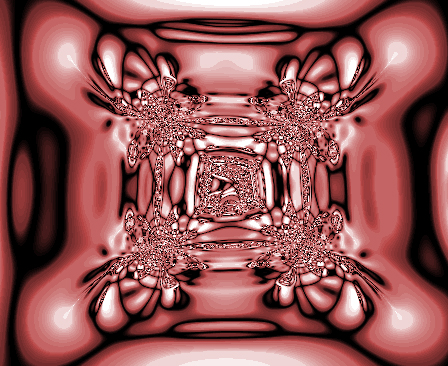|
Iterative
Iteration is the repetition of a process in order to generate a (possibly unbounded) sequence of outcomes. Each repetition of the process is a single iteration, and the outcome of each iteration is then the starting point of the next iteration. In mathematics and computer science, iteration (along with the related technique of recursion) is a standard element of algorithms. Mathematics In mathematics, iteration may refer to the process of iterating a function, i.e. applying a function repeatedly, using the output from one iteration as the input to the next. Iteration of apparently simple functions can produce complex behaviors and difficult problems – for examples, see the Collatz conjecture and juggler sequences. Another use of iteration in mathematics is in iterative methods which are used to produce approximate numerical solutions to certain mathematical problems. Newton's method is an example of an iterative method. Manual calculation of a number's square root is a c ... [...More Info...] [...Related Items...] OR: [Wikipedia] [Google] [Baidu] |
Iterative Method
In computational mathematics, an iterative method is a Algorithm, mathematical procedure that uses an initial value to generate a sequence of improving approximate solutions for a class of problems, in which the ''i''-th approximation (called an "iterate") is derived from the previous ones. A specific implementation with Algorithm#Termination, termination criteria for a given iterative method like gradient descent, hill climbing, Newton's method, or Quasi-Newton method, quasi-Newton methods like Broyden–Fletcher–Goldfarb–Shanno algorithm, BFGS, is an algorithm of an iterative method or a method of successive approximation. An iterative method is called ''Convergent series, convergent'' if the corresponding sequence converges for given initial approximations. A mathematically rigorous convergence analysis of an iterative method is usually performed; however, heuristic-based iterative methods are also common. In contrast, direct methods attempt to solve the problem by a finit ... [...More Info...] [...Related Items...] OR: [Wikipedia] [Google] [Baidu] |
Newton's Method
In numerical analysis, the Newton–Raphson method, also known simply as Newton's method, named after Isaac Newton and Joseph Raphson, is a root-finding algorithm which produces successively better approximations to the roots (or zeroes) of a real-valued function. The most basic version starts with a real-valued function , its derivative , and an initial guess for a root of . If satisfies certain assumptions and the initial guess is close, then x_ = x_0 - \frac is a better approximation of the root than . Geometrically, is the x-intercept of the tangent of the graph of at : that is, the improved guess, , is the unique root of the linear approximation of at the initial guess, . The process is repeated as x_ = x_n - \frac until a sufficiently precise value is reached. The number of correct digits roughly doubles with each step. This algorithm is first in the class of Householder's methods, and was succeeded by Halley's method. The method can also be extended t ... [...More Info...] [...Related Items...] OR: [Wikipedia] [Google] [Baidu] |
Fractals
In mathematics, a fractal is a Shape, geometric shape containing detailed structure at arbitrarily small scales, usually having a fractal dimension strictly exceeding the topological dimension. Many fractals appear similar at various scales, as illustrated in successive magnifications of the Mandelbrot set. This exhibition of similar patterns at increasingly smaller scales is called self-similarity, also known as expanding symmetry or unfolding symmetry; if this replication is exactly the same at every scale, as in the Menger sponge, the shape is called affine geometry, affine self-similar. Fractal geometry lies within the mathematical branch of measure theory. One way that fractals are different from finite geometric figures is how they Scaling (geometry), scale. Doubling the edge lengths of a filled polygon multiplies its area by four, which is two (the ratio of the new to the old side length) raised to the power of two (the conventional dimension of the filled polygon). ... [...More Info...] [...Related Items...] OR: [Wikipedia] [Google] [Baidu] |
Scheme (programming Language)
Scheme is a dialect of the Lisp family of programming languages. Scheme was created during the 1970s at the MIT Computer Science and Artificial Intelligence Laboratory (MIT CSAIL) and released by its developers, Guy L. Steele and Gerald Jay Sussman, via a series of memos now known as the Lambda Papers. It was the first dialect of Lisp to choose lexical scope and the first to require implementations to perform tail-call optimization, giving stronger support for functional programming and associated techniques such as recursive algorithms. It was also one of the first programming languages to support first-class continuations. It had a significant influence on the effort that led to the development of Common Lisp.Common LISP: The Language, 2nd Ed., Guy L. Steele Jr. Digital Press; 1981. . "Common Lisp is a new dialect of Lisp, a successor to MacLisp, influenced strongly by ZetaLisp and to some extent by Scheme and InterLisp." The Scheme language is standardized in the offic ... [...More Info...] [...Related Items...] OR: [Wikipedia] [Google] [Baidu] |
Algorithms
In mathematics and computer science, an algorithm () is a finite sequence of mathematically rigorous instructions, typically used to solve a class of specific problems or to perform a computation. Algorithms are used as specifications for performing calculations and data processing. More advanced algorithms can use conditionals to divert the code execution through various routes (referred to as automated decision-making) and deduce valid inferences (referred to as automated reasoning). In contrast, a heuristic is an approach to solving problems without well-defined correct or optimal results.David A. Grossman, Ophir Frieder, ''Information Retrieval: Algorithms and Heuristics'', 2nd edition, 2004, For example, although social media recommender systems are commonly called "algorithms", they actually rely on heuristics as there is no truly "correct" recommendation. As an effective method, an algorithm can be expressed within a finite amount of space and time"Any classic ... [...More Info...] [...Related Items...] OR: [Wikipedia] [Google] [Baidu] |
Functional Programming Languages
In computer science, functional programming is a programming paradigm where programs are constructed by applying and composing functions. It is a declarative programming paradigm in which function definitions are trees of expressions that map values to other values, rather than a sequence of imperative statements which update the running state of the program. In functional programming, functions are treated as first-class citizens, meaning that they can be bound to names (including local identifiers), passed as arguments, and returned from other functions, just as any other data type can. This allows programs to be written in a declarative and composable style, where small functions are combined in a modular manner. Functional programming is sometimes treated as synonymous with purely functional programming, a subset of functional programming that treats all functions as deterministic mathematical functions, or pure functions. When a pure function is called with some ... [...More Info...] [...Related Items...] OR: [Wikipedia] [Google] [Baidu] |
Infinite Compositions Of Analytic Functions
In mathematics, infinite Function composition, compositions of analytic functions (ICAF) offer alternative formulations of Generalized continued fraction, analytic continued fractions, series (mathematics), series, product (mathematics), products and other infinite expansions, and the theory evolving from such compositions may shed light on the convergence (mathematics), convergence/divergence of these expansions. Some functions can actually be expanded directly as infinite compositions. In addition, it is possible to use ICAF to evaluate solutions of fixed point (mathematics), fixed point equations involving infinite expansions. Complex dynamics offers another venue for iterated function system, iteration of systems of functions rather than a single function. For infinite compositions of a ''single function'' see Iterated function. For compositions of a finite number of functions, useful in fractal theory, see Iterated function system. Although the title of this article specifies ... [...More Info...] [...Related Items...] OR: [Wikipedia] [Google] [Baidu] |
Iterated Function
In mathematics, an iterated function is a function that is obtained by composing another function with itself two or several times. The process of repeatedly applying the same function is called iteration. In this process, starting from some initial object, the result of applying a given function is fed again into the function as input, and this process is repeated. For example, on the image on the right: : Iterated functions are studied in computer science, fractals, dynamical systems, mathematics and renormalization group physics. Definition The formal definition of an iterated function on a set ''X'' follows. Let be a set and be a function. Defining as the ''n''-th iterate of , where ''n'' is a non-negative integer, by: f^0 ~ \stackrel ~ \operatorname_X and f^ ~ \stackrel ~ f \circ f^, where is the identity function on and denotes function composition. This notation has been traced to and John Frederick William Herschel in 1813. Herschel credited ... [...More Info...] [...Related Items...] OR: [Wikipedia] [Google] [Baidu] |
Merge Sort
In computer science, merge sort (also commonly spelled as mergesort and as ) is an efficient, general-purpose, and comparison sort, comparison-based sorting algorithm. Most implementations of merge sort are Sorting algorithm#Stability, stable, which means that the relative order of equal elements is the same between the input and output. Merge sort is a divide-and-conquer algorithm that was invented by John von Neumann in 1945. A detailed description and analysis of bottom-up merge sort appeared in a report by Herman Goldstine, Goldstine and von Neumann as early as 1948. Algorithm Conceptually, a merge sort works as follows: #Divide the unsorted list into ''n'' sub-lists, each containing one element (a list of one element is considered sorted). #Repeatedly Merge algorithm, merge sublists to produce new sorted sublists until there is only one sublist remaining. This will be the sorted list. Top-down implementation Example C-like code using indices for top-down merge sort algorit ... [...More Info...] [...Related Items...] OR: [Wikipedia] [Google] [Baidu] |
Control Flow
In computer science, control flow (or flow of control) is the order in which individual statements, instructions or function calls of an imperative program are executed or evaluated. The emphasis on explicit control flow distinguishes an ''imperative programming'' language from a ''declarative programming'' language. Within an imperative programming language, a ''control flow statement'' is a statement that results in a choice being made as to which of two or more paths to follow. For non-strict functional languages, functions and language constructs exist to achieve the same result, but they are usually not termed control flow statements. A set of statements is in turn generally structured as a block, which in addition to grouping, also defines a lexical scope. Interrupts and signals are low-level mechanisms that can alter the flow of control in a way similar to a subroutine, but usually occur as a response to some external stimulus or event (that can occur asynchr ... [...More Info...] [...Related Items...] OR: [Wikipedia] [Google] [Baidu] |
Algorithm
In mathematics and computer science, an algorithm () is a finite sequence of Rigour#Mathematics, mathematically rigorous instructions, typically used to solve a class of specific Computational problem, problems or to perform a computation. Algorithms are used as specifications for performing calculations and data processing. More advanced algorithms can use Conditional (computer programming), conditionals to divert the code execution through various routes (referred to as automated decision-making) and deduce valid inferences (referred to as automated reasoning). In contrast, a Heuristic (computer science), heuristic is an approach to solving problems without well-defined correct or optimal results.David A. Grossman, Ophir Frieder, ''Information Retrieval: Algorithms and Heuristics'', 2nd edition, 2004, For example, although social media recommender systems are commonly called "algorithms", they actually rely on heuristics as there is no truly "correct" recommendation. As an e ... [...More Info...] [...Related Items...] OR: [Wikipedia] [Google] [Baidu] |




